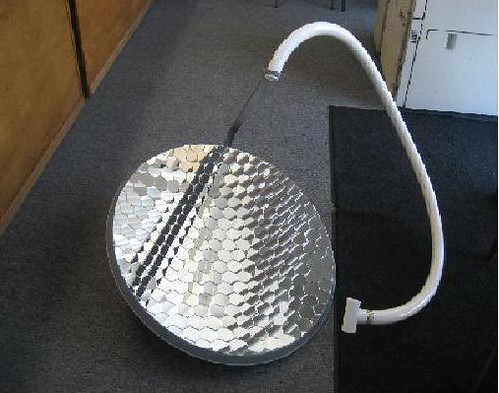Orbit Technology Group announces order worth more than $4m from the French Navy for Ku-band and C-band marine satellite communication systems.
[SatNews – 05/22/2009]
Comtech EF Data introduces point-to-multipoint modem, CDM-740, for satellite IP delivery using integrated DVB-S/S2 receiver and turbo product-coding SCPC modulator.
[Satellite Today – 05/22/2009]
Air Force rebuts General Accounting Office report critical of its management of the GPS program, saying it has plenty of ways to keep up the navigation system.
[Wireless Week – 05/22/2009]
NASA’s return to the moon to get support from two satellites, the Lunar Reconnaissance Orbiter, and the Lunar Crater Observation and Sensing Satellite, to be launched together June 17 by an Atlas V rocket from Cape Canaveral.
[SatNews – 05/21/2009]
Boeing files accusations against NASA of ‘inexplicably" altering evaluation process between the company and its competitor Lockheed Martin in the battle for a $1.1 billion contract for up to four GOES-R weather satellites.
[Satellite Today – 05/21/2009]
Swedish Space receives all necessary approvals from U.S. government for acquisition of U.S.-based Universal Space Network, a leader in satellite telemetry, tracking, and control services.
[SatNews – 05/21/2009]
Seven astronauts expected to return to Earth Friday May 22 after successful 11-day mission to upgrade Hubble telescope.
[SatNews – 05/21/2009]
Hubble considered better than new after the mission; never to be seen by humans again – a robotic spacecraft is to steer it back towards the atmosphere and a "watery grave" after 2020.
[SatNews – 05/19/2009]
Iridium launches third annual "test your satellite phone" week, encouraging emergency workers and first responders to ensure their satellite phone works, to be prepared in case of a disaster.
[PR Newswire – 05/21/2009]
Congressional investigators conclude that poor planning and unproven technologies on key Pentagon space programs led to cost overruns, delays, and possible gaps in military satellite programs.
[AP hosted by Google – 05/21/2009]
RRsat expands access of its content management and global distribution services to Africa via Telstar 11N.
[PR Newswire – 05/21/2009]
Finally – NASA’s PharmaSat nanosatellite and the Air Force Research Laboratory’s TacSat-3 satellite successfully launched from Wallops Island.
[SatNews – 05/20/2009]
NASA’s largest ever parachute, 2,000 pounds and 150 feet in diameter, will allow recovery of the first stage rocket motor of the Ares 1, of the Constellation Program.
[R&D Magazine – 05/20/2009]
Inmarsat selects Arianspace to launch new Alphasat-1-XL satellite using new European platform, Alphabus, and weighing more than six tons, in 2012.
[SatNews – 05/20/2009]
ISS Reshetnev wins contract to build Russian Express satellites.
[Satellite Today – 05/20/2009]
DirectTV continues to top customer satisfaction poll among cable and satellite TV operators, as Comcast has greatest improvement, Cox improves, and Dish Network falls.
[AP hosted by Google – 05/20/2009]
Gateway Communications, the leading provider of African telecommunications services, announces AfricaConnect for South African retail community, following successful implementation in banking, mining, logisitcs, and other sectors.
[TMC news – 05/20/2009]
Eutelsat W2A satellite C and Ku-band go live, transferring service from W1 satellite and immediately initiating service for newly won contracts.
[PR Newswire – 05/19/2009]
Russian Proton-M rocket launches U.S. company ProtoStar’s ProtoStar-2 telecommunications satellite.
[mosnews.com – 05/19/2009]
TerreStar and Space Systems Loral announce arrival of TerreStar-1 in Kourou, French Guiana, teeing up for June 24 launch on Ariane 5.
[Wireless Week – 05/19/2009]
ICO Global Communications files legal challenges against European Commision over exclusive licenses inssued to Inmarsat and Solaris Mobile for S-band MSS services in Europe.
[Satellite Today – 05/18/2009]
Avail Media and TVN merge, with investment from the National Rural Telecommunications Cooperative, offering a possible answer to the absence of IP Prime, which SES Americom has announced it is closing down.
[Fierce IPTV – 05/18/2009]
Airlines race to install Wi-Fi – but how do you squeeze yourself and your laptop into a comfortable work position?
[The New York Times – 05/18/2009]
ATSB re-schedules launch of its remote sensing satellite, RazakSat, for mid-July.
[Satellite Today – 05/18/2009]
Congressmen introduce bill to name "incitive" satelllite broadcasters who broadcast "incitive stations" as terrorists
[Satellite Today – 05/18/2009]
Brazil and the U.S. working to arrest people in Brazil illegally using U.S. Navy FLTSATCOM communications satellites for communications throughout Brazil.
[strategypage.com – 05/17/2009]
NSR report – using stimulus funds to level the playing field, not tilt it – while less than 1% of stimulus package is directed towards broadband initiatives, much attention has been garnered, and present thinking seems to follow a competitive approach that would favor a single technology winner, which would be counterproductive.
[NSR Broadband Satellite Services report – May 2009]
WBMSAT PS – Satellite Communications Consulting Services





